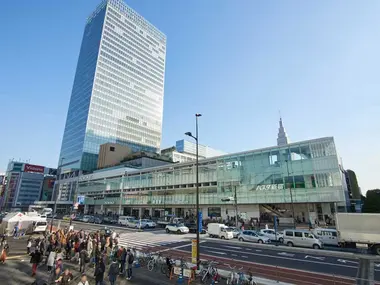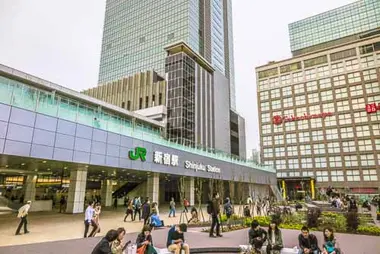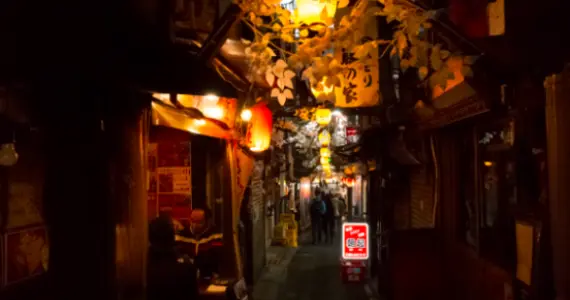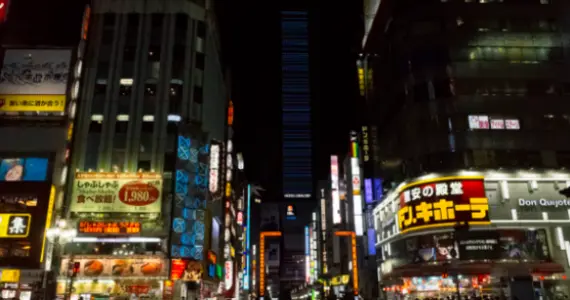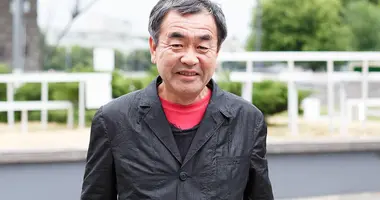Busta Shinjuku: Your gateway to Japan's highway bus network
- Published on : 21/04/2024
- by : Japan Experience
- Youtube

Busta Shinjuku
@flickr/ Dick Thomas Johnson
Busta Shinjuku, officially known as the Shinjuku Expressway Bus Terminal, is Japan's largest and most comprehensive highway bus hub. Located at the south end of Shinjuku Station, this modern facility serves as a crucial transportation nexus, connecting Tokyo to over 300 cities across 39 prefectures. Since its opening on April 4, 2016, Busta Shinjuku has revolutionized long-distance bus travel in Japan, consolidating 19 scattered bus stops into one efficient terminal. With 15 platforms serving 207 routes operated by 118 companies, it handles an impressive 38,000 passengers daily, offering travelers a cost-effective alternative to Japan's renowned rail system.
What is Busta Shinjuku and why is it important?
Busta Shinjuku is the main bus and taxi terminal of Shinjuku Station, one of Tokyo's busiest transport hubs. Its significance lies in its role as a centralized departure point for highway buses traveling throughout Japan. The terminal's creation was a response to the need for better organization of bus services and reduced traffic congestion around Shinjuku Station.
The project, initiated in 2006 by the Ministry of Land, Infrastructure, Transport and Tourism, took a decade to complete. It was administered by the East Japan Railway Company and is now operated by a company jointly owned by the Nihon Bus Association and 11 major bus companies. The name "Busta" itself is a clever portmanteau of "bus" and "terminal", chosen through a public naming competition.
For travelers, Busta Shinjuku offers a more affordable option for long-distance travel compared to trains. While bus journeys may take longer, they often cost about half the price of a bullet train ticket and provide access to more remote destinations that might not have train stations. This makes it an attractive choice for both domestic and international tourists looking to explore Japan on a budget.
Navigating Busta Shinjuku: Layout and facilities
Busta Shinjuku is a four-story complex integrated with Shinjuku Station and the adjacent NEWoMan shopping center. Here's a breakdown of its layout:
- 1st Floor: Directly connects to the southern platforms of Shinjuku Station.
- 2nd Floor: Features three southernmost gates of Shinjuku Station, the Ekinaka Ekisoto Food Hall, railway ticket machines, and a View Plaza ticketing office where travelers can exchange their Japan Rail Pass.
- 3rd Floor: Houses the taxi stand, bus arrival platforms, the Shinjuku WE Bus departure point, and the Tourist Information Center Tokyo.
- 4th Floor: Contains the highway bus platforms, ticket office, and waiting area. This floor is divided into four color-coded areas:
- Area A (orange): Tohoku Expressway, Joban Expressway, East Kanto, Tokyo Bay Aqua Line, airports, and short-distance buses
- Area B (blue): Tomei Expressway, Chuo Expressway
- Area C (green): Kan-etsu Expressway
- Area D (purple): Kansai and Hokuriku routes
Access between floors is via escalators at the front and elevators at the back. The terminal also features coin lockers, a convenience store, ATMs, free Wi-Fi, and a nursery on the 5th floor.
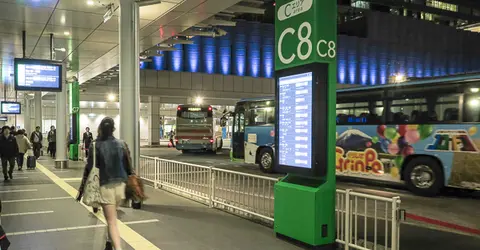
Busta Shinjuku Terminal
@Japan Visitor
Highway bus services: Connecting Tokyo to destinations across Japan
Highway buses departing from Busta Shinjuku offer an extensive network of routes, reaching major cities and tourist destinations throughout Japan. Some popular routes include:
- Tokyo to Sendai: Approximately 6 hours, with fares ranging from 3,000 to 7,200 yen.
- Tokyo to Nagano: About 4 hours, with tickets priced between 1,500 and 4,800 yen.
- Tokyo to Kyoto/Osaka: Around 9-10 hours, costing between 5,400 and 15,000 yen.
- Tokyo to Kanazawa: Approximately 8 hours, with fares starting from 4,500 yen.
Over 100 bus companies operate from Busta Shinjuku, with hundreds of buses departing daily. This variety ensures that travelers can find suitable options for their budget and schedule. However, it's important to note that the terminal can be challenging for foreign visitors due to insufficient English signage and guidance. Travelers are advised to arrive early and seek detailed information when purchasing tickets.
Beyond buses: Taxis, local transport, and tourist information
While highway buses are the primary focus, Busta Shinjuku offers additional services to enhance travelers' experiences:
Taxis: The third floor houses the only authorized taxi stand for the South Gate of Shinjuku Station, providing convenient access for those preferring door-to-door service.
Shinjuku WE Bus: This local loop bus, operated by Keio Dentetsu Bus, departs from the third floor and connects various points of interest in east and west Shinjuku, including the Tokyo Metropolitan Government Building and Kabukicho.
Tourist Information Center Tokyo: Located on the third floor, this center provides multilingual assistance to visitors, offering tourism information, iPad stations for self-service research, and even baggage storage and forwarding services. It's open daily from 6:30 am to 11 pm.
Shopping and dining options at Busta Shinjuku
Busta Shinjuku isn't just about transportation; it also offers various shopping and dining experiences:
NEWoMan: This adjacent shopping complex occupies the first five floors of the 32-story JR Shinjuku Miraina Tower. It features fashion boutiques, lifestyle goods stores, cafes, and restaurants. The 2nd floor Ekinaka Ekisoto Food Hall, shared with Busta Shinjuku, is open from 7 am to 2 am, offering quick dining options for travelers.
Souvenir Shop: Located within the terminal, this shop offers a variety of local souvenirs from Tokyo and surrounding areas, perfect for last-minute gift shopping.
South Side Terraces: These landscaped areas on the second and third floors provide a pleasant space for relaxation, offering views of the trains below and access to the shops and hotels of Shinjuku Southern Terrace.
How to access Busta Shinjuku from Shinjuku Station
Accessing Busta Shinjuku is straightforward, with several options available:
1. New South Gate: The most direct route, offering immediate access to the terminal. Open from 5:45 am to midnight.
2. Koshu-kaido Gate: Located on Koshu-kaido Avenue.
3. Miraina Tower Gate: Inside Busta Shinjuku, in front of the NEWoMan entrance.
4. South Gate: Exit Shinjuku Station and cross Koshu-kaido Road.
All these access points are on the second floor of Busta Shinjuku. For those coming from other parts of Shinjuku Station, clear signage in English helps guide the way.
Tips for a smooth experience at Busta Shinjuku
To ensure a hassle-free journey from Busta Shinjuku, consider the following tips:
1. Arrive early: The terminal can get crowded, especially during peak hours (around 9 am and 4 pm). Allow extra time for ticket purchase and locating your departure platform.
2. Double-check your ticket: Confirm the route number, bus company, departure time, and destination carefully to avoid boarding the wrong bus.
3. Use the information counter: Located on the 4th floor, staff can assist in English and Japanese from 7 am to 11 pm.
4. Utilize coin lockers: If you have time to explore before your departure, store your luggage in one of the available coin lockers.
5. Take advantage of the facilities: Make use of the free Wi-Fi, ATMs, and convenience store before your journey.
6. Consider online booking: To avoid queues, book your tickets online where possible.
By following these guidelines and making the most of Busta Shinjuku's facilities, you can ensure a comfortable start to your journey across Japan. Whether you're a budget traveler or simply looking to experience a different side of Japanese transportation, Busta Shinjuku offers an efficient and economical gateway to explore the country.
About the Shinjuku Area
To say that Shinjuku encapsulates central Tokyo would be a vast understatement. The main Shinjuku Station is a multi-faceted complex interconnected with different underground tunnels and multi-story department stores. It is the busiest station not just in Japan but the world, with an average of 3.5 to 4 million commuters going through every day. Shinjuku being a major travel hub means, in turn, its surrounding areas are full of discoveries, from local Izakayas, counter space-only bars, endless shopping, and just great streets to walk around, especially at night, when the residents of Tokyo come out to socialize and have fun! Photographers especially will enjoy the distinct nighttime scenery, perfectly suited for street pictures! Adventure one of Tokyo's most iconic locations with a local guide to unlock some of its most premier attractions.
